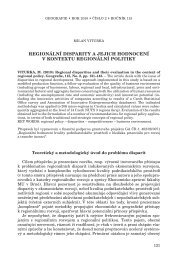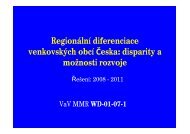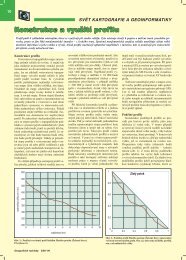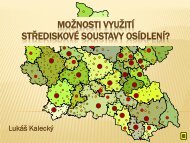land use and landscape changes in czechia during the period of ...
land use and landscape changes in czechia during the period of ...
land use and landscape changes in czechia during the period of ...
Create successful ePaper yourself
Turn your PDF publications into a flip-book with our unique Google optimized e-Paper software.
Tab. 1 – Typology <strong>of</strong> <strong>the</strong> <strong>changes</strong> <strong>of</strong> <strong>the</strong> macrostructure <strong>in</strong> CTU <strong>of</strong> Czechia 1990–2000. Macrostructure:agricultural <strong>l<strong>and</strong></strong>, forest areas <strong>and</strong> o<strong>the</strong>r areas (water + built-up + rema<strong>in</strong><strong>in</strong>g).Type CTU number % Size 2000 (ha) %+ + + 141 1.58 54,187.7 0.69+ + – 1,904 21.39 1,500,680.7 19.03+ – + 490 5.50 418,246.8 5.30+ – – 1,234 13.86 905,517.0 11.48– + + 2,543 28.56 2,368,246.6 30.02– + – 905 10.17 946,005.0 12.00– – + 1,686 18.94 1,693,655.3 21.48Total 8,903 100.00 7,886,539.1 100.00Source: Database LUCC Czechia 2001, Charles University <strong>in</strong> PragueTherefore it is important that <strong>the</strong>se pressures are compared with <strong>the</strong> previous<strong>l<strong>and</strong></strong> <strong>use</strong> categories <strong>and</strong> classes.We <strong>use</strong> two methods to do so. The first evaluates <strong>the</strong> <strong>l<strong>and</strong></strong>scape’s macrostructurebased on agricultural <strong>l<strong>and</strong></strong>, forest areas <strong>and</strong> o<strong>the</strong>r areas (water + builtup+ rema<strong>in</strong><strong>in</strong>g) through a simpler form <strong>of</strong> <strong>in</strong>creases <strong>and</strong> decreases <strong>in</strong> areabetween two time <strong>period</strong>s. This allows seven categories <strong>of</strong> <strong>l<strong>and</strong></strong> macrostructuretransition categories to be dist<strong>in</strong>guished (Tab. 1).Compar<strong>in</strong>g <strong>the</strong> development <strong>of</strong> <strong>the</strong> shortest <strong>l<strong>and</strong></strong> <strong>use</strong> change <strong>period</strong>(1990–2000) with <strong>the</strong> preced<strong>in</strong>g <strong>period</strong> (1948–1990) documents a fundamentallydifferent situation. In our op<strong>in</strong>ion a decade is too short a time for significant<strong>l<strong>and</strong></strong> <strong>use</strong> <strong>changes</strong> to occur. What more <strong>the</strong> fundamental change <strong>in</strong>ownership relations when <strong>l<strong>and</strong></strong> was returned to 3.5 million people throughrestitution certa<strong>in</strong>ly <strong>in</strong>fluenced <strong>the</strong> variety <strong>of</strong> <strong>changes</strong> <strong>in</strong> <strong>l<strong>and</strong></strong> <strong>use</strong>. The oldest<strong>period</strong> (1845–1945) was <strong>in</strong>fluenced by <strong>the</strong> fact that <strong>in</strong> more than 60 % <strong>of</strong> CTUs<strong>the</strong>re was forest growth (whe<strong>the</strong>r we count <strong>the</strong> portion <strong>of</strong> CTUs or <strong>the</strong> area <strong>of</strong>units). In only a quarter <strong>of</strong> CTUs did <strong>the</strong> area <strong>of</strong> agricultural <strong>l<strong>and</strong></strong> grow <strong>and</strong> <strong>in</strong>a full 75 % o<strong>the</strong>r areas grew (built-up + water + rema<strong>in</strong><strong>in</strong>g). The second <strong>period</strong>concentrated <strong>the</strong> number <strong>and</strong> area <strong>of</strong> each type to 90 % – i.e. CTUs whereagricultural <strong>l<strong>and</strong></strong> decreased <strong>and</strong> forest <strong>and</strong> o<strong>the</strong>r areas <strong>in</strong>creased. Thus, <strong>the</strong><strong>period</strong> <strong>of</strong> transition with its vary<strong>in</strong>g types <strong>of</strong> <strong>l<strong>and</strong></strong> structure dynamics presentsa specific phase <strong>of</strong> development. Of course we presume that after complet<strong>in</strong>g<strong>the</strong> database <strong>in</strong> January 1, 2010 that <strong>the</strong> transition al development <strong>of</strong> twentyyears will be projected <strong>in</strong> <strong>the</strong> representation <strong>of</strong> two or three types.Table 2 is based on <strong>the</strong> methods <strong>of</strong> Slovene geographers (Gabrovec, Kladnik,Petek 2001) <strong>and</strong> with a certa<strong>in</strong> amount <strong>of</strong> generalization it documentsma<strong>in</strong> <strong>l<strong>and</strong></strong>scape change processes. It is based on simplified <strong>l<strong>and</strong></strong> structure <strong>in</strong>four basic categories: total arable <strong>l<strong>and</strong></strong> + permanent cultures, also permanentgrass<strong>l<strong>and</strong></strong> area (meadows + pastures), forests <strong>and</strong> total built-up <strong>and</strong> rema<strong>in</strong><strong>in</strong>gareas. The largest positive growth <strong>in</strong> area is divided by <strong>the</strong> sum <strong>of</strong> all areagrowth <strong>and</strong> is multiplied by 100. The result<strong>in</strong>g number expresses how <strong>the</strong>most significantly grow<strong>in</strong>g category contributed to total positive <strong>changes</strong>. If<strong>the</strong> portion is larger than 75 % it is a strong process, if it is between 50–74.9 %it is <strong>of</strong> medium <strong>in</strong>tensity, <strong>and</strong> if <strong>the</strong> portion is 25–49.9 % it is weak. Depend<strong>in</strong>gupon which unified category is <strong>in</strong> question we can talk about three levels <strong>of</strong>273








